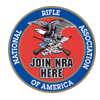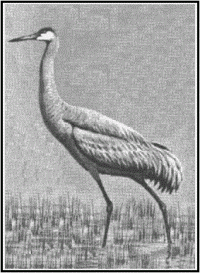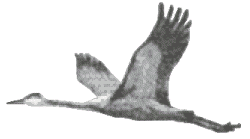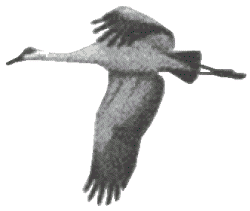
| "Snipe" Hunt | July 1994 | |
| Gerhard Schroeder
| ||
We reluctantly think about crawling out of our sleeping bags. Somebody left the sky wide open and now it is cold -- unexpectedly cold -- worse than during December elk hunts. In the east, the horizon hints that soon a sun will rise. We fire up the lanterns, hoping they will warm up the air inside our Toyota camper shell. That offsets the cold a little for Glenn Sampson and myself, but poor David Stimens was sleeping, or at least trying to, outside under a tarp. He is really bitching up a storm and refuses to leave his bag until the coffee water is steaming. Eventually the three of us are ready to head into the field. In the distance, over the playa, we hear the birds calling. Yes, we got drawn for Sandhill Crane, two tags per hunter. The Sandhill Crane is the tallest North American bird that can legally be hunted. It also has one of the most beautiful, far-carrying calls in the wild; that in this case overpowers the continuous humming of the nearby power station. We grab our 12 gauge armament, camo face net, and decoys, cross a nasty barb-wire fence and move along a deserted, partially overgrown, concrete-lined irrigation ditch. A couple of hundred yards from our camp we set up three home-made decoys within easy range in front of us, spread out about 40 steps, and stare east into the dark sky. Even with binoculars we see only faint outlines of far mountains, but the cranes get noisier by the minute. So does our shaking since the cold always intensifies at daybreak. Eventually, the first flight is spotted, as they have lifted off the shallow lake down in the playa, and are now going off to the south, away from us. But more follow, gaining altitude and flying in formations not unlike Allied bombers during WWII. Within minutes, hundreds of birds are in the air, in groups of as little as 2 and as large as about 50 or more. Add to it the thousands of loud, almost purring calls and you are experiencing an unforgettable morning! Only problem is, of the by-now over a thousand birds, none seem to steer our way, but in virtually every other direction. David and Glenn also see all these cranes leave and finally ask: "Why did you take us to this damn place?" I respond, "Be patient. It always looks as if no sandhills come this way at first light, but they will eventually show." At least exactly that happened the last three times that I had been hunting sandhill cranes here. On my first ever hunt I arrived late on opening morning only to have the longnecks fly across the road I was approaching on. Although I missed the opportunity for the early action, it eventually led to success. Following all those flights of cranes with my 10X binoculars revealed where they landed. It was right by that ditch we are sitting in now. That the cranes' primary defense is their excellent eyesight I discovered rather quickly. My attempt to sneak closer (like into shotgun range) was soon abandoned when all those tall birds took to the wings at a distance where even Quigley would have gone hungry. So I spent the rest of the morning getting to that location by the concrete ditch with my old Toyota. When I found the place, all birds were gone. Around noon, those thousands of cranes returned to the playa, way up out of range where you could hear but barely see them. And they stayed at the playa that afternoon, where no hunting is allowed. Sort of out of boredom I changed from 3" #2's to homegrown 2-3/4" #6's and headed into the bushes. Not expecting much I was soon into some quail. But not just some quail, they were scaled quail, a first for me to hunt those. Gambel's were also in the area. They kept me busy all afternoon, and 8 in all were stupid enough to fly into my 12 gauge patterns. The next morning found me waiting in that ditch! Eventually, sandhill cranes did fly over, actually allowing me to take a double! Aside from having to check in the birds at the Game & Fish station located east of the playa, that hunt was over. These guys took field data like sex, age, weight and size.
But wait! There is another group of sandhills calling. I assume a low profile. The stretched-out birds come closer, right on course, but quite high. The double barrel goes to the shoulder and barks twice into the grey sky. Those cranes must not have heard my shots, they keep right on flying! Oh well, there come some more! But these guys aren't impressed by my shooting ability, either. Several flights later, with me all but out of ammo, I finally hear some pellets actually hit birds, smacking their feathers. But the cranes were just too far up -- the #2 shot didn't get results. I give it up and join David and Glenn who never got birds within range. We remain in the field for another half hour until all crane noise fades out. Time to see if the quail are still in the area. We leave the sandhill decoys behind and load up with small shot. We find the quail, but the numbers are low. It takes a lot of walking to bag a couple. But they keep us doing something to pass the day. Later in the afternoon, nature calls for Glenn. So he walks over to the fence to do his thing. Doesn't take a gun. Sees that instead of three decoys there are six! Realizes that he's not drunk, so those others must be real birds. But of course they aren't drunk, either, and leave in a hurry. Yes, it was way too far for a shotgun, even with slugs. But, one of us should have camped his sorry rear end in the tumbleweed blind, which was within easy range for even a .410. So, no long legs were decorated with a filled-out tag on the first day. The early morning ritual is repeated the next day. However, to provide a little variation, the sandhill cranes, flying high and safe on day one, now decide to land way short of our location. Fine. So we watch them through the binos. It is a thing of beauty to observe these stretched-out, big birds approach on landing, set their flaps, circle to lose altitude, and at the last moment thrust their long, skinny, naked legs forward to get that springy kind of landing, finished off with a few fast steps. But why do they have to show off their stuff so far out of range? Oh well, we'll just wait until they fly closer. Right! Something eventually sets them back in motion, but not our way. And the few that do are using oxygen masks by the time they pass over us. So much for the second morning. We pack up camp, and cruise around in the neighborhood. No sitting ducks, errr, cranes anywhere. So we decide to head in the direction of home, but stop on the way for one more encounter with scaled quail. For me, crane hunting only seems to work, and work just fine, if I go it alone. So far that's been 100% success. When I take somebody along because I tell them that it's like having an appointment with those sandhills, my bragging gets rewarded with zip. And if you ask David or Glenn, they'll tell you, that back in '92 Gerhard took them on a damn snipe hunt, down there all the way over near Wilcox!
© Honeywell Sportsman Club. All rights reserved. | ||
| If you enjoyed this story, or found it useful, please consider clicking here to join the NRA at a discount of $15 off the normal membership cost. You will be supporting both this website and adding your voice in support of the Second Amendment. Thank you very much. |

|

|
|

 Two seasons later I returned with two guys from work. They each tagged one, Lance on
Saturday, Mark on Sunday. I struck out, including another stalking attempt. A couple of
seasons later I returned alone, again taking a double, hidden in that same ditch.
Two seasons later I returned with two guys from work. They each tagged one, Lance on
Saturday, Mark on Sunday. I struck out, including another stalking attempt. A couple of
seasons later I returned alone, again taking a double, hidden in that same ditch.










